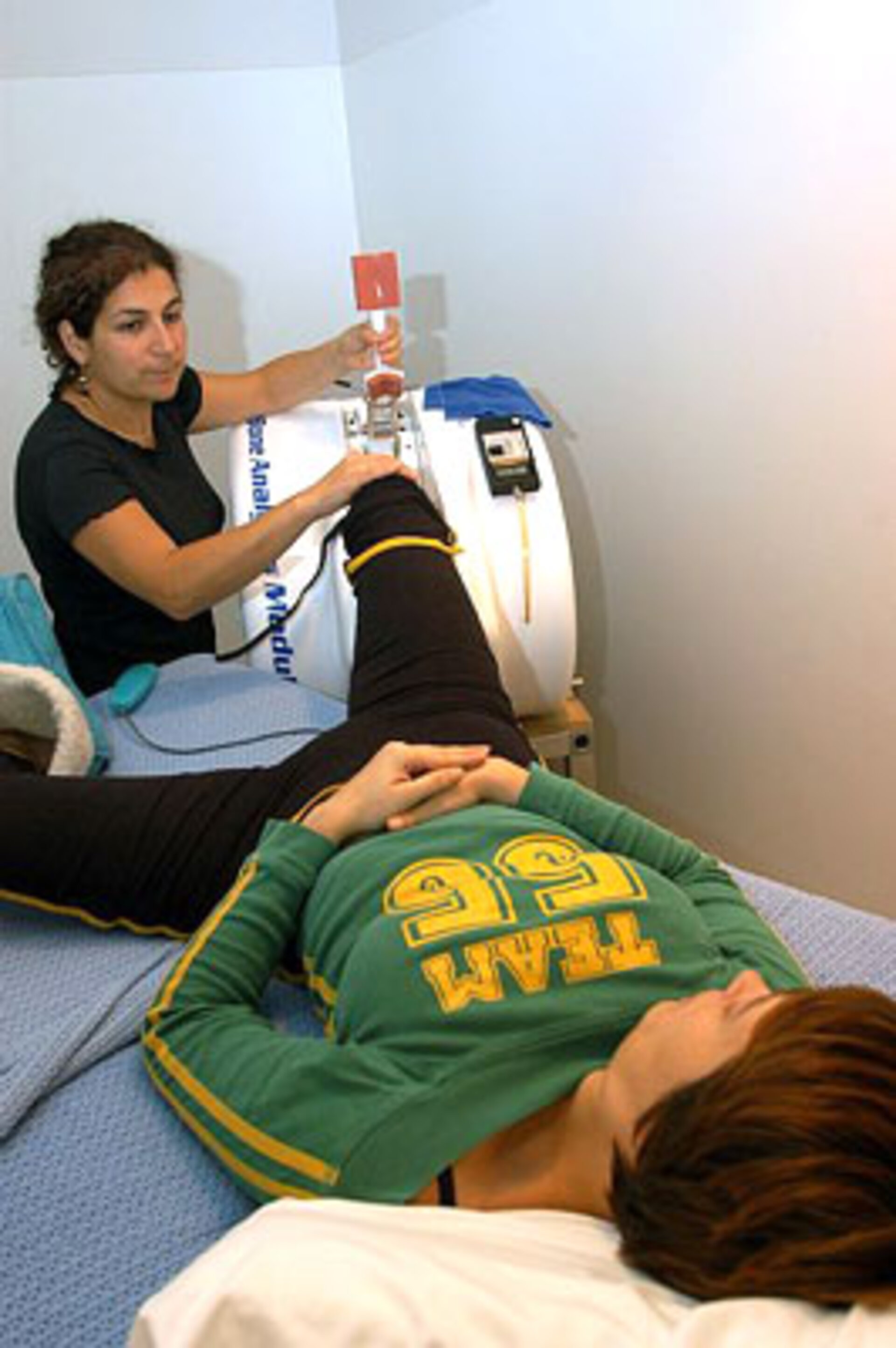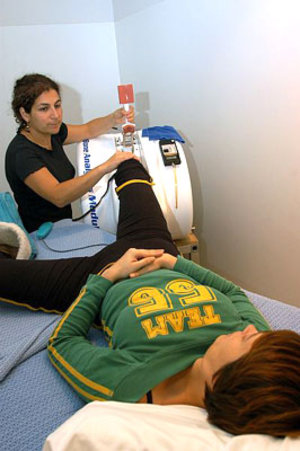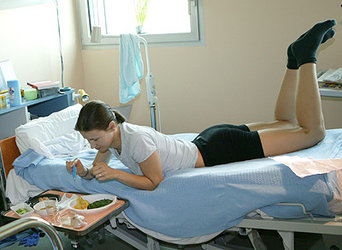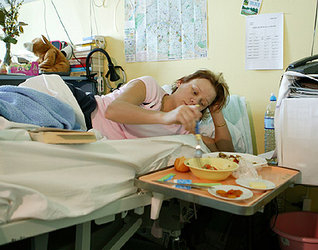After 60 days in bed, it's time to get up!
The second round of the women 'bed rest' experiment being carried out by ESA and CNES has now been completed. The 12 volunteers are back on their feet again, after spending two whole months lying down.
At the CNES Institute for Space Medicine and Physiology (MEDES) in Toulouse, this second group of 12 female European volunteers spent 60 days lying down on beds tilted at an angle of 6º, their heads positioned slightly lower than their feet. Lying in this position prompts over time certain physiological changes similar to those caused by extended periods of exposure to the weightless conditions of space.
This bed rest campaign forms part of the Women International Space Simulation for Exploration study. The WISE 2005 study is being carried out jointly by the European Space Agency, the French space agency CNES, the Canadian Space Agency and NASA. It is needed in order to address gender-specific differences between male and female astronauts. The first group of 12 women underwent their 60-day stint in bed back in March-May.
The female volunteers are subjected to certain conditions simulating those experienced by astronauts on long-duration space missions. Weightlessness eventually results in loss of muscle, fluid and bone mass. But this experiment is not specifically designed to study those phenomena. The real object of the exercise is to test measures that could be used to counter the adverse effects of weightlessness on astronauts and ascertain which ones are best for female crew members. The test subjects were therefore divided into three groups in order to try out different counter-measures: a control group, an exercise group taking physical exercise on apparatus adapted to a lying-down position and a nutrition group whose diet included protein supplements.
To obtain statistically reliable results, an overall sample group of 24 was required, which is why this second set of 12 volunteers – comprising one Scot, one Swiss-German, three Fins and seven Frenchwomen – checked into the MEDES Space Clinic in September to take part in this second round.
Two identical sessions
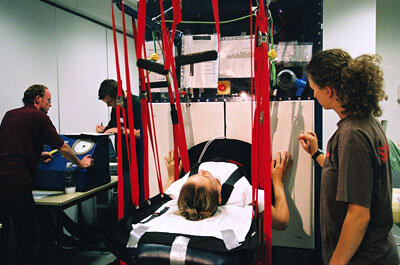
As Peter Jost, ESA project coordinator, explains: "One of the hardest challenges in conducting this experiment the second time round was to reproduce precisely the same procedures and the same experimentation, in order to end up with a coherent set of results."
Arnaud Beck, medical coordinator of the MEDES-based simulation, adds: "We took great care to redo things exactly the same as the first time round, with the same people being assigned to the same tasks."
The regime followed by this second group of a dozen volunteers was scrupulously identical to that of the first session. However, this time, an extra effort was made by the kitchen staff at the Rangueil Hospital in Toulouse to improve the quality of the meals, to make them more appetising, without altering their strictly-monitored nutritional content.
Peter Jost explains: "To keep their bones healthy, the volunteers eat large amounts of fruit and vegetables. But we have to take account of their digestive capacity, which is reduced by stomach displacement in the ribcage in the bed rest position." Under these conditions, where meal intake in itself is a difficult exercise, it was vital to make things as agreeable as possible.
Satisfying the volunteers' information needs was also handled a little differently this time round. An interpreter working full-time was on hand to assist the medical team, making it easier to deal with certain subtle cultural differences. The end result was a highly-motivated team of volunteers, well aware of the study's scientific importance and of the necessity of certain forms of experimentation - and certain restrictions too.
During the two months, the 12 volunteers were far from idle. They were required to undergo regular medical checks, psychological monitoring and - in the case of the group of four testing the exercise counter-measure - do physical exercise. They were able to do language classes, and even drawing classes. They received various visits, including one from explorer Stéphane Lévin, an expert in surviving extreme environmental conditions. They also met their counterparts from the first session, who were back in Toulouse for a series of follow-up checks, six months after their return to a normal daily routine.
Visiting astronauts
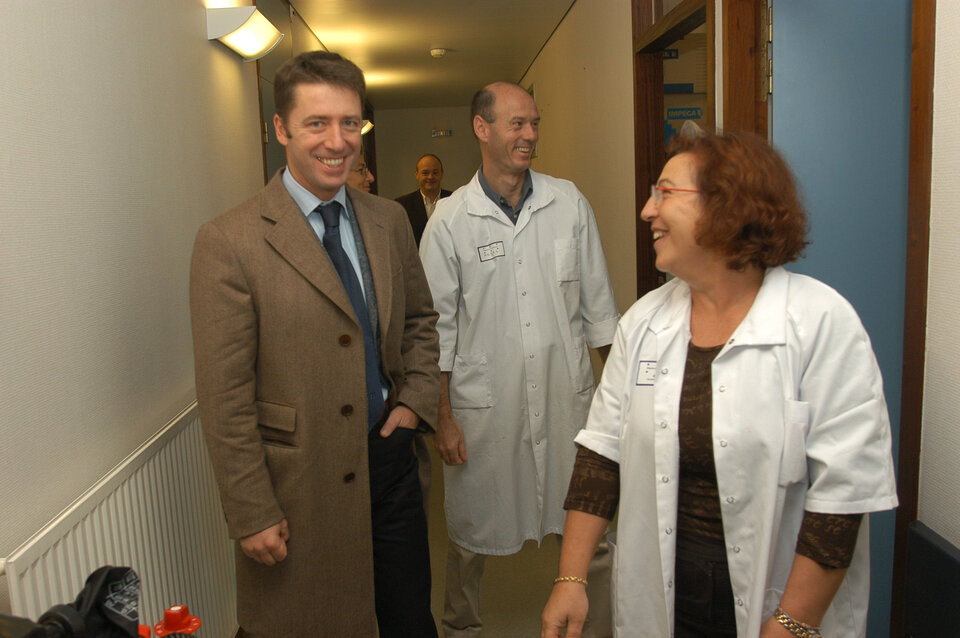
Last week, two astronauts visited the volunteers to share some of their experiences of spaceflight with them. First came Italian Roberto Vittori, who has twice flown on Soyuz missions to the International Space Station and was in Toulouse for a conference on future missions to Mars. Three days later came Frenchman Michel Tognini, the Director of the European Astronaut Centre in Cologne, and veteran of two flights, one Soyuz mission to the Mir station and the other aboard Space Shuttle Columbia.
Roberto Vittori commented: "It is funny to see how the volunteers have organised their confined personal space around their beds, with their laptop computer and all the usual items within reach. This is indeed very similar to our living conditions onboard the Space Station. Up there too, we lead an isolated existence. The laptop is a key part of daily life and not just for work."
He added: "In a weightless environment, we float and lose muscle and bone mass. It is almost like being half-way between a bird and a fish." That analogy is an interesting one for Peter Jost, who sees the space environment as a kind of reverse evolution process. "On emerging from the water, our amphibious ancestors needed to acquire a more solid bone structure and more powerful muscles in order to move about on dry land. And in a weightless environment, our bodies re-adapt and we shed what we no longer need."
Countering this physiological reflex will be extremely important when human space exploration extends beyond the immediate vicinity of the Earth and interplanetary expeditions lasting several months are undertaken. Following such journeys, astronauts will have to work in spacesuits on planetary surfaces where they will be subjected once more to the forces of gravity. And they will have to be able to readapt to that environment without the support of terrestrial medical infrastructure. For men and women to be able to undertake such journeys, the planned counter-measures will need to be validated for both sexes – which is where WISE comes in.
For Roberto Vittori, who has already twice experienced the process of readapting to gravity conditions, the WISE experiment is "precisely the kind of research we need to carry out if we want to go to Mars one day."
'Return to Earth'

With the volunteers now back on their feet again, the critical rehabilitation phase of medical check-ups has started, in order to gather a huge amount of data following this 'return to Earth'.
By the end of their extended bed rest, the first-round volunteers had lost some bone mass but not sufficiently to warrant talk of osteoporosis. Arnaud Beck explains: "Their results were lower down but still within the normal data range. Within six months, most of the data were back to normal."
They did however lose three to four kilos of muscle, mainly lower down the body, above all in the extensors (the muscles which enable us to keep upright), less so in the flexors (used for bending the limbs). The speed of recovery varies from organ to organ: a matter of days for some, months for others. After three weeks of physiotherapy, most of the volunteers felt fine and ready to resume a perfectly normal daily routine. Within 24 hours, all of them were able to walk (although in some cases with their sense of balance impaired somewhat). After three days, they were allowed to run in order to undergo tests. Peter Jost explains: "Walking is easier than standing upright, as muscle exertion helps with blood circulation. Clearly, making demands on muscles that had been unused for two months was a bit difficult at first."
It is vital for the experimenters to get the best possible understanding of the processes through which the body adapts to weightlessness and gravity, if effective counter-measures are to be developed for future astronauts. But this experimentation also has many applications here on Earth. Various conditions are being investigated thanks to the WISE simulation: osteoporosis; metabolic syndrome, which endangers the health of sedentary workers not taking physical exercise; and the medical rehabilitation of long-stay bed-ridden hospital patients. "We even have a team from the Netherlands studying the formation of micro blood clots such as those which could cause vein trouble in passengers on long-haul flights who have to remain seated for hours on end."
Awaiting the first results

With the active phase of the study having now ended, the 12 international teams of scientists are excited at the prospect of being able to share their results and together build up an aggregate picture. They will need another few months in order to analyse all the data and publish the first findings.
This joint international WISE study is a particularly complex, multi-disciplinary undertaking which took two years to set up. So far, it has proved a resounding success.
Much remains to be learned about human physiology and the body's capacity to adapt to outer space. As Roberto Vittori sums up: "One of the facts of life of scientific research is that we do not always know what we are going to come up with. One good way of prompting further progress is to take a look at what we know already, but from a different angle. In medicine, microgravity provides us with precisely that different perspective on the human body."
And thanks to the WISE bed rest campaign simulating certain features of the astronaut's environment, a good deal more is being learned about how the female body in particular responds to such conditions. This knowledge will be invaluable in planning long-duration space exploration missions.
For more information, contact:
Franco Bonacina
ESA Media Relations Division
Paris (France)
Tel: +33 1 5369 7155
Fax: +33 1 5369 7690
Dieter Isakeit
Erasmus User Centre and Communication Office
Directorate of Human Spaceflight, Microgravity and Exploration Programmes
Noordwijk (The Netherlands)
Tel: +31 71 565 5451
Fax: +31 71 565 8008
Peter Jost
WISE Coordinator
ESA/ESTEC
Tel: +31 71 565 66 12


